Ellipse
| Subject classification: this is a mathematics resource. |
Ellipse

Origin at point .
Foci are points
Line segment is the
Line segment is the
Each line is a
Each line is a
In cartesian geometry in two dimensions the ellipse is the locus of a point that moves relative to two fixed points called The distance from one to the other is non-zero. The sum of the distances from point to foci is constant.
See figure 1.
The center of the ellipse is located at the origin and the foci are on the
at distance from
has coordinates has coordinates . Line segments
By definition
the length of the
Each point where the curve intersects the major axis is called a are the vertices of the ellipse.
Line segment perpendicular to the major axis at the midpoint of the major axis is the with length
Any line segment that intersects the curve in two places is a A chord through the focus is a Each focal chord
perpendicular to the major axis is a
Equation of ellipse
Let point have coordinates
Make appropriate substitutions, expand and the result is:
or
If the equation is expressed as
Length of latus rectum
Length of latus rectum
Second definition of ellipse
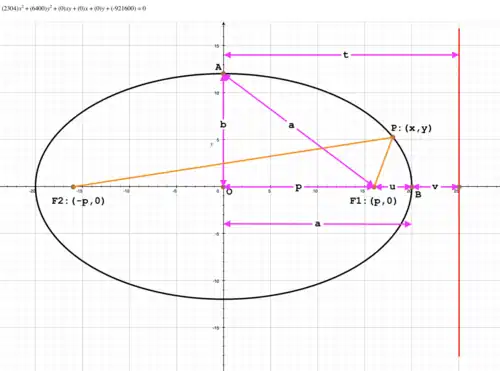 Graph of ellipse where .
At point At point Ellipse is path of point that moves so that ratio of distance to fixed point and distance to fixed line is constant.
Therefore, Let directrix have equation where At point
Statement is true at point also.
|
Proof
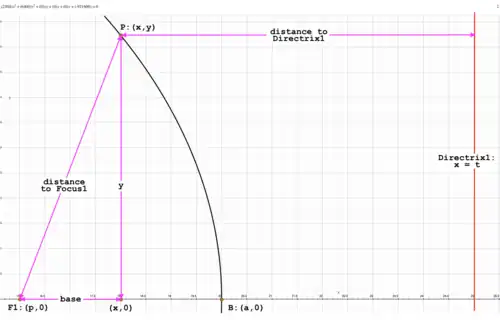 Proving that .
Graph is part of curve distance to Directrix1 base = As expressed above in statement second definition of ellipse states that ellipse is path of point that moves so that ratio of distance to fixed point and distance to fixed line is constant.
base
Therefore: where
|
The directrices

Origin at point .
Foci are points
Directrices are lines
(yellow lines); (purple lines)
To define ellipse specify
See Figure 1. The vertical line through with equation is a of the ellipse. Likewise for the vertical line
A second definition of the ellipse: the locus of a point that moves relative to a point, the focus, and a fixed line called the directrix, so that the distance from point to focus and the distance from point to line form a constant ratio
Consider the point in the figure.
Let the length
Consider the point :
Length .
Distance from center to directrix
Distance from center to directrix = .
.
.
.
Distance from focus to directrix .
Ellipse using focus and directrix

Origin at point .
Focus at point
Directrix is line
Point has coordinates:
(yellow lines)
See Figure 2. Let the point be , the focus be and the directrix have equation where
The directrix is horizontal and the major axis vertical through the origin .
Expand and the result is:
Compare this equation with the equation generated earlier: .
When the equation is the major axis is horizontal.
When the equation is the major axis is vertical.
General ellipse at origin
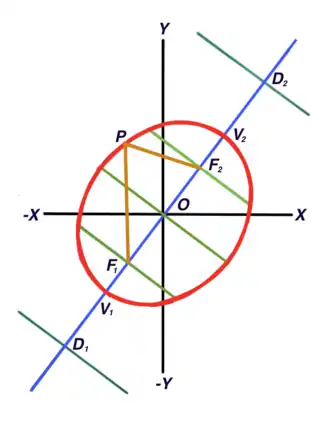
Origin at point .
Foci are points
Line segment is the
Line is the major axis extended.
Lines perpendicular to at are directrix, latus rectum. minor axis, latus rectum, directrix.
The general ellipse allows for the major axis to have slope other than horizontal or vertical. See Figure 1.
The line is the major axis of the ellipse shown in red. Points are the foci with
coordinates respectively.
Point is any point on the curve. By definition
Length
Length
Make appropriate substitutions, expand and the result is:
.
This equation has the form where:
because center is at origin,
An example
Let be (3,4) and
The ellipse is: or
Reverse-engineering ellipse at origin
Given an ellipse in format calculate is non-zero.
Coefficients provided could be, for example, or
or where is an arbitrary constant and all groups of coefficients define the same ellipse.
To produce consistent, correct values for the equations become:
or:
Solutions are:
. This formula for is valid if both are .
where
You should see one positive value and one negative value for Choose the positive value and .
The solutions become simpler if K == 1.
if ( K != 1 ) { A ← KA; B ← KB; C ← KC; } and the solutions for become:
where
With values available all the familiar values of the ellipse may be calculated:
Equation of major axis: in normal form.
Equation of minor axis: in normal form.
Equations of directrices: in normal form.
An example using focus and directrix
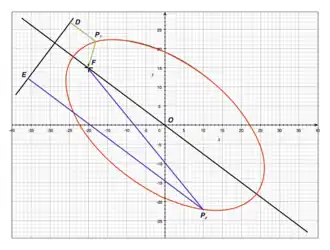
Origin at point .
Focus at point
Directrix is line
eccentricity
Ellipse has equation:
Given focus and directrix with equation ,
calculate equation of the ellipse in form
See Figure 2. Let point be any point on the ellipse.
Distance from to focus
Distance from to directrix .
.
.
.
.
Expand and the result is:
Because the center of the ellipse is at the origin and the various lines have equations as follows.
Minor axis:
Other directrix:
Major axis:
If you reverse-engineer the ellipse using the method above, ,
the expression becomes , and
the expression becomes .
General Ellipse

Foci at center at
Point is a vertex. Length
The ellipse may assume any position and any orientation in Cartesian two-dimensional space. See the red curve in Figure 1.
The equation of this curve may be derived as follows:
Given two of length and point
The expansion of this expression is somewhat complicated because it contains 5 variables
The expansion may be simplified by reducing the number of variables from to , the familiar
Let , the center of the ellipse, have coordinates where and
Then and
The expansion is: where:
A different approach
Begin with ellipse at origin: where:
By translation of coordinates, move the ellipse so that the new center of the ellipse is: ← ←
The equation above becomes: where:
the same as the value of in the method above.
The expansion of will show that this method produces the same results as the method above.
Given foci and major axis, perhaps the simplest way to produce is to calculate
and move the center from to .
Center of ellipse
Given we know from above that
Therefore where the point is the center of the ellipse.
An Example of the General Ellipse

Red curve and green curve have same size, shape and orientation. The only difference is that center of green curve has been moved to where it is the center of the red curve.
In both curves
See Figure 1. Given foci and calculate the equation of the ellipse in form
Calculate the center:
Equation of ellipse at origin:
Move ellipse from origin to
Reverse-engineering the general ellipse
Given ellipse calculate the foci and the major axis.
Calculate the center of the ellipse (point ):
Solutions are:
where
In this example,
If != ← ← ←
The values may be calculated as in "Reverse-engineering ellipse at origin" above.
Length of major axis
Focus
Focus
Significant lines of the Ellipse

Directrix through
Directrix through
Latus rectum through
Latus rectum through
Major axis
Minor axis
The significant lines of the ellipse are: each each
Consider the ellipse in Figure 2. Given foci and calculate the equations of all the significant lines.
Slope of major axis
Major axis has equation and it passes through
Therefore,
Major axis has equation:
Center of ellipse
Minor axis is perpendicular to major axis. Therefore, minor axis has equation: and it passes through the center
Equation of minor axis (orange line through ): or or
Using the equation of the minor axis, the fact that each latus rectum is parallel to the minor axis, and that the distance
from minor axis to latus rectum each latus rectum has equation:
Equation of latus rectum (blue line) through
Equation of latus rectum (blue line) through
Using the equation of the minor axis, the fact that each directrix is parallel to the minor axis, and that the distance from minor axis to directrix each directrix has equation:
Equation of directrix (red line) through
Equation of directrix (red line) through
K and "Standard Form"

For green curve
For red curve
For blue curve
Everything about the ellipse can be derived from the last three of which are contained within:
for ellipse at origin.
Consider the ellipse: the green curve in Figure 1. It is tempting to say that
These values satisfy
However, These values for are not correct.
Put the equation of the ellipse into "standard form." In this context "standard form" means that
For ellipse at origin
In fact
← ← ← ←
The equation of the ellipse becomes: and
The equation of the ellipse is in "standard form" and:
The values are correct.
Example 2. Consider the ellipse the red curve in Figure 1.
In this example, and the equation in "standard form" is:
.
Example 3. Consider the ellipse the blue curve in Figure 1.
The center
In this example and the equation in "standard form" is:
.
Tangent at latus rectum

Origin at point .
Red curve is ellipse at origin with major axis vertical.
Line is directrix:
Line passes through point
Line is tangent to curve at Latus Rectum:
See Figure 1. The red curve is that of an ellipse at the origin with major axis vertical:
The line is the directrix with equation:
The green line has equation:
The aim of this section is to show that the line is tangent to the ellipse at the
Let the line intersect the curve. The coordinates of the point of intersection are given by:
If the line is a tangent, has one value and the discriminant is
or:
The tangent has slope and equation:
Let this line intersect the curve. The coordinates of the points of intersection are given by:
Discriminant =
half length of latus rectum.
The tangent touches the curve where , the point where is the latus rectum.
Reflectivity of ellipse
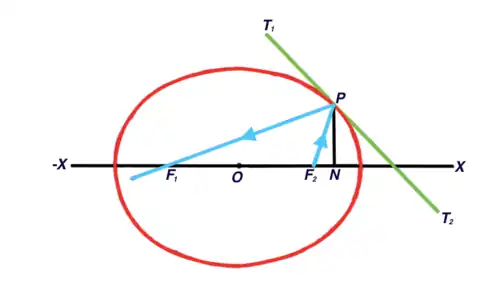
Origin at point .
Foci are points
Line tangent to curve at .
Angle of incidence = angle of reflection:
See Figure 1.
The curve (red line) is an ellipse with equation: where
Foci have coordinates
Line is tangent to the curve at point
A ray of light emanating from focus is reflected from the inside surface of the ellipse at point and passes through the other focus
The aim is to prove that
Point has coordinates
At point
Slope of line
Slope of line
Slope of curve at
Using ,
if then:
,
,
and
where
If you make the substitutions and expand, the result is .
Therefore, angle of reflection angle of incidence and the reflected ray passes through the other focus